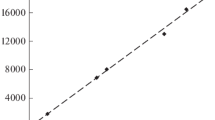Summary
The slight linear decrease of the “per mole of AgI adsorbed amount” (¯C) of the coagulating ion with the increasing pI at a constant concentration of the coagulating ion was proved and explained by the linear decrease of the specific surface.
The adsorbed amount of the coagulating ions at a constant concentration and at a given pI decreases with the increasing concentration in which the AgI precipitate was formed.
Ions of different valencies are adsorbed in equivalent amounts which are independent of their concentrations which were higher than their coagulation values.
The correctness of the desorption-adsorption formula logc″/c′=(z′−z″ a+ logx/(−x) respectivelyS=c″ (1−x)/c′x= 10(z′−z″)a was confirmed (x the fraction of the adsorbed amount of the ion of valencyz″ and concentrationc″, 1−x the fraction of the adsorbed amount of the ion of valencyz′ and concentration c′,S the selectivity coefficient of ion exchangers). Therefore the coagulated AgI can be considered as an ideal ion exchanger.
The constanta in the above formula is equal to the slope of the line “log coagulation value-valency” of theSchulze-Hardy rule.
Zusammenfassung
Die leicht lineare Abnahme des pro Mol AgJ adsorbierten Betrages (¯C) der koagulierenden Ionen mit steigendem pJ bei konstanter Konzentration des koagulierenden Ions wurde gezeigt und durch die lineare Abnahme der spez. Oberfläche erklärt.
Der adsorbierte Betrag an koagulierenden Ionen bei konstanter Konzentration und gegebenem pJ sinkt mit steigender Konzentration, mit der die AgJ-Fällung erzeugt wird.
Ionen verschiedener Wertigkeiten werden in äquivalenten Beträgen unabhängig von ihren Konzentrationen adsorbiert und sind höher als ihre Koagulationswerte.
Die Richtigkeit der Desorption-Adsorptions-Formel logc″/c′=(z′−z″ a+logx/(−x) bzw.S=c″ (1−x)/c′x= 10(z′−z″)a wurde sichergestellt (x= Bruchteil des adsorbierten Betrages des Ions der Valenzz″ und dessen Konzentrationc″, 1 −x=Bruchteil des adsorbierten Betrages des Ions der Valenzz′ und der Konzentration c′,S=Selektivitätskoeffizient des Ionenaustauschers). Deshalb kann das koagulierte AgJ als ein idealer Ionenaustauscher betrachtet werden.
Die Konstantea in der obigen Formel ist gleich der Neigung der Kurve “log Koagulationswert/Valenz” in derSchulze-Hardy-Regel (2).
Similar content being viewed by others
Reference
Herak, M. J. andM. Mirnik, Kolloid-Z.168, 139–143 (1960).
Mirnik, M., Nature190, 689 (1961).
Author information
Authors and Affiliations
Additional information
Contribution number 95 from the Department of Physical Chemistry, Faculty of Sciences, University of Zagreb.
Partially reported at the I. Yugoslav Congress for Pure and Applied Chemistry, Zagreb, June 1960.
Rights and permissions
About this article
Cite this article
Herak, M.J., Mirnik, M. Determination of ion adsorption by radioactive tracer technique. Kolloid-Zeitschrift 179, 130–134 (1961). https://doi.org/10.1007/BF01520100
Received:
Issue Date:
DOI: https://doi.org/10.1007/BF01520100



